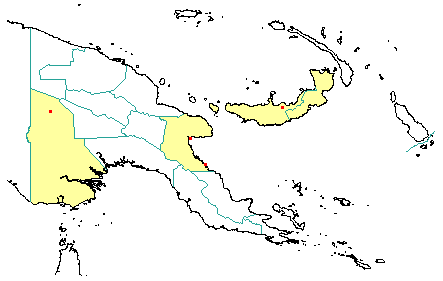
in PNGplants database
PNGTreesKey – Neonauclea hagenii (Lauterb. & K.Schum.) Merr. |
Barry Conn (NSW) & Kipiro Damas (LAE).
Guide to trees of Papua New Guinea
Copyright held by the authors, National Herbarium of New South Wales, and Papua New Guinea National Herbarium
Journal of the Washington Academy of Science Vol. 5: 540 (1915)
Other Literature: C.E. Ridsdale, Blumea 230-234 (1989) Fig. 11-(plate; map)-22.
Family: Rubiaceae
Dicotyledon
Timber Group: Non-timber species
Field Characters: Small sub-canopy tree (10-20 m high) or Large canopy tree (up to 30 m high); Bole cylindrical (up to c. 50 cm diam.); straight (bole up to c. 12 m long); buttresses buttresses present (buttresses short); spines spines absent; aerial roots aerial roots absent; stilt roots stilt roots absent; Bark brown or grey, rough, slightly fissured, often pustular, or sometimes scaly or flaky, lenticels elongated vertically; Subrhytidome (under-bark) pink; less than 25 mm thick; bark blaze consisting of one layer; faintly to non-aromatic; outer blaze white, pink, yellowish brown, or pale yellow, markings absent, fibrous; inner blaze white, yellowish brown, pale yellow, or pink, markings absent, fibrous; bark exudate (sap) absent; terminal buds enclosed by leaves.
Indumentum: Complex hairs absent; stinging hairs absent; mature twig indumentum (hairs) absent.
Leaves: Leaves spaced along branches, opposite (in pairs, opposite one another on the branchlet), simple (a leaf composed of a single blade); petiole present, not winged, attached to base of leaf blade, not swollen; leaves broadest at or near middle, (8.0-) 12.0-20.0 (-23.0) cm, (3.0-) 5.0-9.0 (-12.0) cm; symmetric, entire, not dissected or lobed, sub acute, venation pinnate, secondary veins open, not prominent, but visible, intramarginal veins absent; leaves lower surface pale green, upper surface dark green, indumentum (hairs) absent; absent; domatia absent; stipules present, joined, joined across twigs, not encircling the twig, leafy, fringed (minutely and finely hairy or with only a few minute scattered hairs), large (usually 8-16 mm long, rarely as long as 20 mm), not persistent.
Flowers: Inflorescence terminal, flowers arising from a single point, cones absent; perianth present, with distinct sepals and petals whorls, inner perianth cream-coloured or white; 5, some or partly joined; stamens 5, present (short), free of each other, joined to the perianth; ovary inferior, carpels joined (when more than one), locules 2; styles solitary.
Fruits: Infrutescence arising from single point (forming a globular fruiting head 25-30 mm diam., sometimes as small as 20 mm.), fruit pale brown, not spiny, non-fleshy, dehiscent (each fruitlet), capsule (each fruitlet splitting into 4 values); seeds 1 (per fruitlet; many per globular fruiting head), to about 5 mm long, winged (shortly at both ends), narrow (longer than wide) (somewhat bilaterally flattened), seed 1-10 mm diam. (c. 2 mm diam.).
Distribution: Morobe, Western (subsp. papuana) & New Britain.
 | Botanical records in PNGplants database |
Notes: Notes Two subspecies occur in Papua New Guinea, namely subsp. hagenii and subsp. papuana. Neonauclea hagenii subsp. hagenii has a flower with a glabrous corolla which is 9-12 mm long and mature fruiting heads (20-)25-30 mm diam., whereas, subsp. papuana has a hairy corolla which is 7-9 mm long, and mature fruiting heads 20-25 mm diam.